
7 Returns Management Software for eCommerce Businesses [2023 Updated List]
Check out this list with the top 7 returns management software for eCommerce businesses and decide which one fits your needs the best.
Boost customer experience and reduce support tickets
Realtime order and shipment tracking
Proactive order and shipping notifications
Predictive pre-purchase estimated delivery dates
Self-Serivce branded order tracking
Effortless experience delivered
Make returns profitable and delight customers
Flexibility to define any return destinations & conditions
Simplify returns for your customers and team
Incentivize exchanges over returns
Returns management made easy for your team
Understand why your customers are returning
Unify the online and the in-store experience
Hassle-free pickup experience for customers
In-Store Dashboard to keep operations streamlined
In-Store and Online orders unified
Drive foot-traffic to your stores
Boost customer experience and reduce support tickets
Realtime order and shipment tracking
Proactive order and shipping notifications
Predictive pre-purchase estimated delivery dates
Self-Serivce branded order tracking
Effortless experience delivered
Make returns profitable and delight customers
Flexibility to define any return destinations & conditions
Simplify returns for your customers and team
Incentivize exchanges over returns
Returns management made easy for your team
Understand why your customers are returning
Unify the online and the in-store experience
Hassle-free pickup experience for customers
In-Store Dashboard to keep operations streamlined
In-Store and Online orders unified
Drive foot-traffic to your stores
Find the answer to all your questions
Explore the most comon questions about WeSupply
Calculate the ROI that WeSupply can bring you
Request a no strings attached review of your current shopping experience and missed conversion opportunities
Take a step by step trip through our functionality to see how we can improve your ecommerce processes.
Read actionable articles on how to optimize your post-purchase experience and decrease support tickets
Get inspired by stories of how our customers implemented an effortless post-purchase experience
A Deep Dive into Top Companies' Order Tracking & Returns Strategy
Wondering if WeSupply is a good fit for you? Read through our use cases to see how we can help you increase conversion & improve CX!
[FREE Fraud Prevention Checklist]
50+ return policies to prevent fraudulent returns!
Get all the Return Policies you need to eliminate Return Abuse!

The customers are always right— except when they’re not.
Some of them love buying your products online. And some of them also love returning merchandise, often on no real basis. And this can definitely take a toll on your business finances.
In fact, you, like many other online retailers, have to deal with a lot of situations, and this includes returns abuse and returns fraud. As the names of these concepts suggest, these events are far from pleasant for online merchants, legitimate customers, or the staff involved in the returns process. From returning stolen merchandise and price switching to other types of abusive returns, consumer abuse comes in all shapes and sizes.
If you want to clearly understand the difference between return abuse, return fraud, or even “friendly fraud”, you’ve come to the right place. In this article, we’ll discuss all of the above to help you figure out what is happening with your returns and how to escape this vicious cycle.

When you think about eCommerce business success, what comes to your mind?
Although we’re not able to read your thoughts, we know for sure that poor customer experience is not on your mental list. In fact, transforming website visitors into loyal customers is one one the main goals for any online retailer.
But there’s a fine line between creating the best experience for your customers by offering full cooperation, flexible returns policies, or a variety of return options, and putting your business at risk of lost revenues due to abusive or even fraudulent returns.
Beware that in 2021, online purchase returns increased in major product categories, ranging from 8% to 88%, with clothing retailers experiencing eCommerce returns the most (source). Moreover, In 2020, 5.9% of all returns were fraudulent, equivalent to $25.3 billion, according to a report by the National Retail Federation.

To avoid these unpleasant scenarios while maintaining or improving customer relationships, the first step is to take a close look at the difference between return abuse and return fraud.
First of all, we have the good old bracketing. Some retailers might consider it abusive, others may turn a blind eye when it comes to this practice. In a recent survey, 40% of consumers said they bracketed their purchases at least occasionally, and the numbers seem to be increasing as we speak (as you’re reading this, actually).
However, one may argue that the act of bracketing does not have the intention to do any harm to online and omnichannel retailers. Simply buying a shirt in a couple of different sizes or colors and returning the one that doesn’t fit as well is not that unusual or damaging to a business, and can be solved quite easily.
For instance, Missguided turns bracketing into opportunity. After all, their business model thrives on user-generated content and word of mouth online, as seen below:
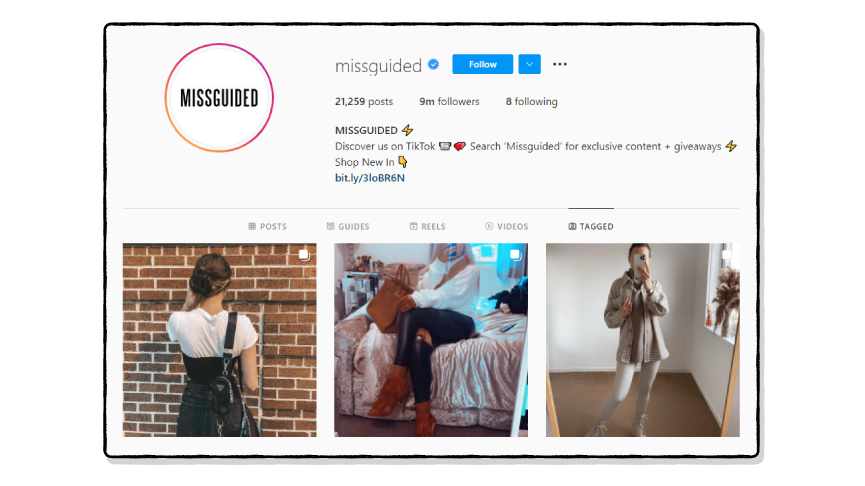
You can update your products descriptions and add accurate information regarding the model’s height and other body measurements. Additionally, you can upload multiple photos from different angles, a 360-degree overview, and so much more! With a little bit of effort and patience, you can go a long way in combating bracketing.
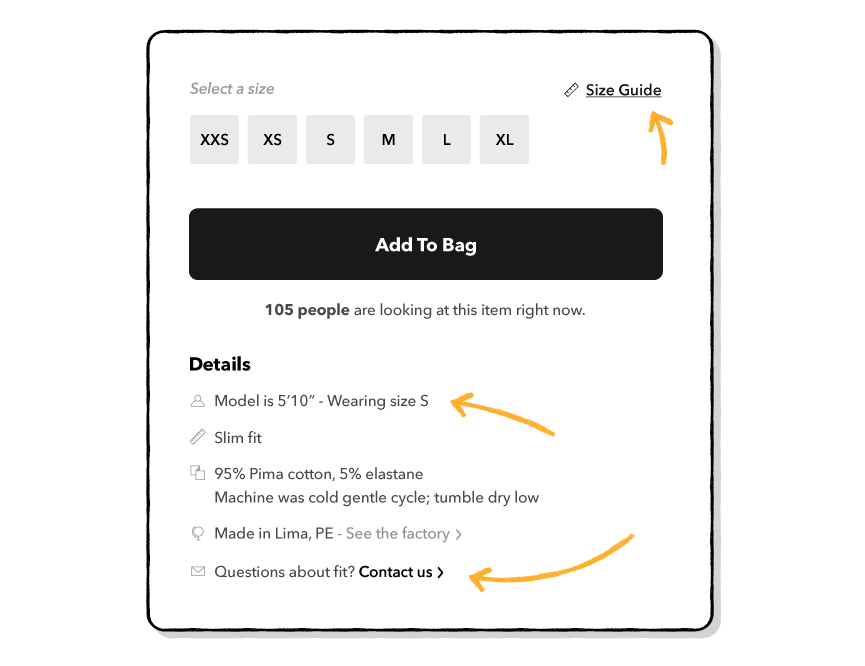
But what happens if your customer keeps doing the same over and over again, ordering the same item in all sizes and all colors, buying your products in bulk, and then returning more than half of the initial order? What if they keep returning an item after using it up partially or even entirely? What about situations when they’re trying to return an obsolete item that can no longer be used or sold?
Those are most likely examples of return abuse. As a matter of fact, a fundamental distinction between regular return activity and abuse is intent—when there’s malicious intent behind the return, that’s when you’re looking right at returns abuse.
Another great example you should keep in mind is the concept of online retail “renting” or borrowing (aka wardrobing). This is when you buy a product and use it for a short time with the intent to return it to the store so you can get your money back.
Just think of all fashion hauls on the internet, where people buy a lot of clothes (and we mean a lot) to try them on, write a review, make a video, grab some attention, gain some momentum, and then return them. Shoppers tuck in the tag on apparel items, wear them a couple of times— often on a special occasion, then repackage and return them.
Brands all over the world had to deal with bracketing, abusive returns, even return fraud, including online fashion brand Asos and omnichannel retail beauty brand Sephora. Desperate times call for desperate measures, pushing brands to take action by banning certain customers from returning items, as the situation calls for it.
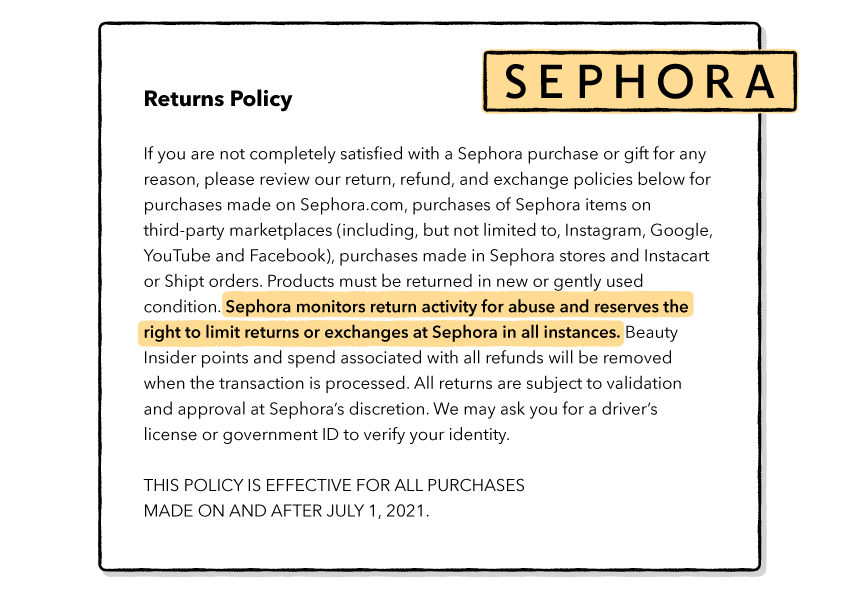
Besides, these practices go far beyond the beauty and fashion industries— offenders do this to a variety of products, from electronics to other tools used for a particular one-time or short-term event or job. This is undoubtedly unethical, but technically legal, so you need to fend for yourself.
Return fraud can be considered the most extreme form of return activity that goes as far as violating the law, depending on your location and local regulations, unlike return abuse that still abides by the law.
Price manipulation or price switching is one of the most common types of return fraud. It refers to the practice of replacing one item for another before making a return. Most often, those who commit fraud this way will purchase two items (similar or not) that have different prices, switch packaging, and return the cheaper item as the higher-priced item, cashing in the rest. Another case is returning an item different from what was purchased, a fake or stolen item, or an item purchased from another retailer at discount.
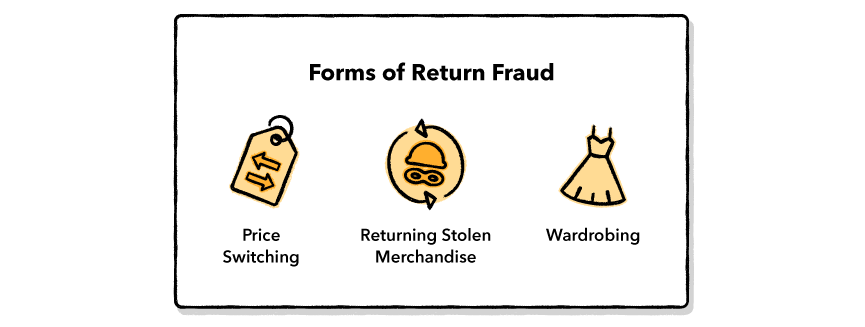
Friendly fraud happens when a customer is taking advantage of goods or services, then claiming it wasn’t them who made the purchase, or that they didn’t actually receive the goods, requesting a refund from a false claim and keeping the items. This is why it’s called ‘friendly’ fraud, more specifically because the customer’s claims are seemingly honest. Unfortunately, a 2020 survey found that 41% of retailers saw an increase in friendly fraud, whereas 51% saw an increase in refund abuse.

Similarly, chargeback fraud, which is sometimes also referred to as friendly fraud, happens when a customer makes a purchase with their card (credit or debit) and then requests a chargeback instead of going through the normal returns flow from the retailer’s website.
When it comes to chargeback fraud, it often occurs by mistake when well-intentioned customers misunderstand return policies or are under the impression that a chargeback is another way to get their money back. There’s no easy way to solve this, but you can surely be more clear in your return policy and provide comprehensive instructions your customers can follow.
However, there are also individuals who do this for personal gain, regardless of the consequences, so keep an eye on any suspicious activity to further avoid this from happening.
Fraudulent returns and how to avoid them

In this section, we’ll take a look at the main steps you can take to protect your business from return abuse while making the shopping and post-purchase experience better for your legitimate customers!
The very first step to reduce and discourage abusive returns is to implement a returns policy that allows flexibility for your customers while protecting your bottom line. Although “no-questions-asked” return policies might help attract and retain new customers. The implications of accepting returns under any circumstances can take a toll on your business in the long run, from increased costs of returns to negative effects on your brand image.
In this regard, clearly state the condition in which products should be returned (e.g., products should be unused, invoice included, and tags attached). Let your customers know whether or not you accept returning customized products, perishable items, and personal care items.
Besides the money you’ll be losing due to fraud and abuse, think of the decreased operational efficiency. Managing abusive returns, from processing them and shipping them back to your locations to restocking and reselling (in some fortunate cases), your customer support team, merchandisers, and so on, will have to do the extra work instead of focusing on what really matters!
If you need help creating yours, check out our return policy generator here!
Once you have a well-established return policy, you need to enforce it and make sure customers follow it. If not, individuals might take advantage of the existing loopholes in your policies. After all, you don’t want your customers returning items that do not meet your return policy guidelines, right?
If your returns management platform enables you, implement a return policy enforcer, to ask customers a simple yes/no question about their purchase before approving the return. This way, you can automatically filter some of the deceptive returns from legitimate ones. Your staff can then manually go through return requests and make an informed decision to further prevent return abuse.
WeSupply provides online and omnichannel retailers with the Return Policy Enforcer solution to help them ensure that only policy-compliant returns are accepted while keeping non-compliant ones aside until thoroughly inspected by one of your employees.
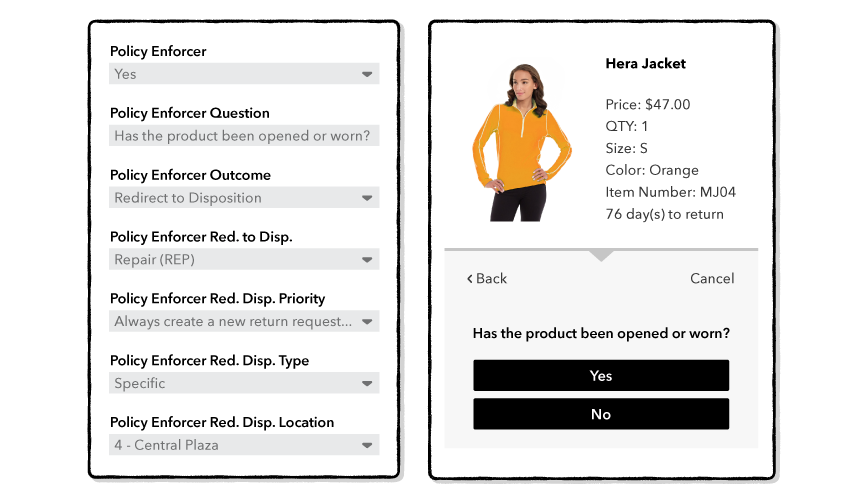
Once you automatically filter return requests, the next step is to have a thorough return inspection process in place. This will help ensure your business does not accept back items that have been used or swapped out for fake ones. Keep in mind that, in 2020, annual sales losses from counterfeiting in the clothing sector alone reached 26.3 billion euros or approximately 29.6 billion USD.
Additionally, you should consider refunding each item as you receive them after your staff has carefully examined each and every one of them. Partial refunds are, in fact, a great way to steer clear of return abuse and fraud.
For instance, if a customer marks 5 items for return but sends back to your warehouse only 3 of them, reimbursing them the amount for all items can put your business at risk of return abuse or even return fraud. Not refunding items until all of them reach your return locations is often unpleasant for the customer and negatively impacts brand loyalty.
Let’s be real, no one wants that. Therefore, the best solution is to partially refund returns— it’s a win-win situation for both your business and your customers.
Dealing with return abuse can be challenging, but you don’t have to do this on your own. We’re here to help you better track your orders to know exactly when the package reaches your customer’s doorstep— no more failed delivery or missing package scams.
Moreover, our returns management system enables your loyal customers to handle returns by themselves while giving you complete control on your end through the return policy enforcer, partial refund, and much more!
For additional details, make sure you check out our Self-Service Returns Center and watch our demo!
How to handle return abuse and fraud?
Check out the guide below to learn more about return abuse and fraud!
Learn how automated
returns work in WeSupply!
Our shipping and logistics experts will guide you through the product and analyze how WeSupply best fits your eCommerce needs.

Check out this list with the top 7 returns management software for eCommerce businesses and decide which one fits your needs the best.
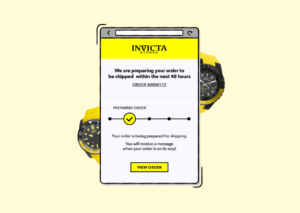
WeSupply developed a custom solution (now fully available for everyone) that detects the originating warehouse for each product automatically and, when a return is created for multiple products, and it generates multiple labels based on each product’s return warehouse.

Return labels are a fundamental part of the returns process, but what is the most effective way to generate them? Learn in this article!
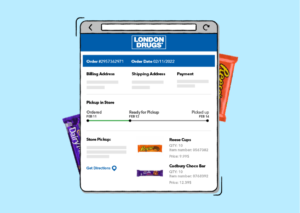
By Working with Kibo and SalesForce, WeSupply helps London Drugs improve the buyer’s experiences across all touchpoints by providing a branded tracking interface and proactive SMS and email alerts from the time a customer presses ‘buy’ until the package is delivered.

Atmos found what they were looking for in WeSupply’s fully customizable tracking page. With our page Atmos goes beyond offering their customers valuable shipping and returns information.

Like most online retailers, Snipes is no exception. Jako’s
support team were constantly fielding “Where’s my order?” phone calls from
customers – sometimes the same day the item was purchased!

Don’t let international eCommerce challenges stop you from growing. Here you’ll find 5 tips for improving the international returns process.

Handling dropshipping returns can be challenging. In this article, we’ll discuss the most common return mistakes and how to deal with them!
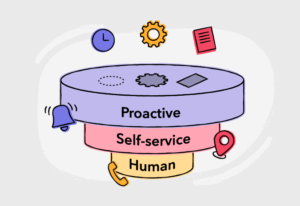
You’ve worked hard to create a positive and memorable online shopping experience for your customers, and now you have the opportunity to deliver your products right into their hands! But what can you do when something unexpected happens during the shipping process?